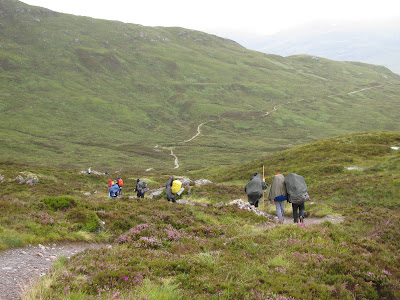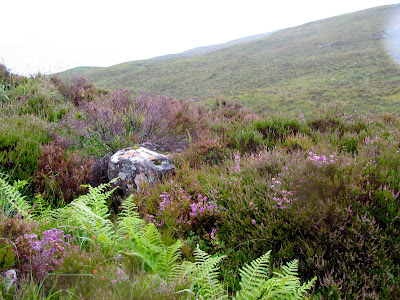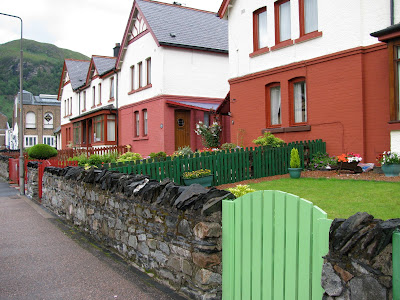Who dares do more, is none.
- Shakespeare's Macbeth
Our day started with a steep climb from the floor of Glen Leven to an old military road that will take us almost to Fort William, 15 miles from our guest house in Kinlochleven, so there will be no tarrying around today. Looking back, we had a good view of the town, Riven Leven as it emptied into Loch Leven, the huge pipes coming down the mountain from the Blackwater Reservoir and the mountains of Glencoe in the distance. The weather was a bit overcast, but not raining. Yeah! But then, this is Scotland where you never know what the day will bring.

Following the valley of the Allt Nathrach (stream of the snake), we continued up to the Lairigmore (the great pass) and ruin of an old farmhouse, Tigh-na-sleabhaich (house on the gullied slope). It was all sounding like we were on our way to Mordor. Love those Gaelic names, but I never figured out how to pronounce them like a Celt.
The Lairigmore is a long, isolated mountain pass at 1080' between high bare hills on our left and the munros of the Marmores on our right.

Beyond the Lairigmore, huge swaths of forest plantation had been clear cut leaving the mountain side bare, and we came across another of those signs about a "plant". Not even the English gentleman behind the sign with whom I had been walking for a while knew what "plant in operation" might mean. He was indignant these trees had been cut down in 2007 and no replacements yet planted. The plan was to remove plantation trees and plant native trees. Why cut all these trees and leave the mountain exposed to erosion?

A bit further on we were walking in the footsteps of Macbeth, the last Celtic king of Scotland from 1040-1057. A sign along the path said Macbeth had stayed on the crannog, an ancient artificial island made of stone and timber, in the little lake, Lochan Lunn Da-Brha. I wasn't sure whether to be more excited about Macbeth or that I finally had seen a crannog. I had been looking for one ever since Loch Lomond. I remembered Patty had said once while working on our genealogy we had an ancestor related to Macbeth. Either the crannog was a vacation home for Macbeth or he was trying to get away from some enemies, probably the latter. His stomping ground was more in eastern Scotland.

We left the military road for a path across moorland with a good view of the great Ben Nevis (mountain with its head in the clouds). The Ben is the highest of the Scottish munros and the highest mountain in Great Britain at 4406'. Many a climber has cut their teeth on this mountain before heading to the Himalaya.

The cold wind had picked up across the moorland, and we were hungry, looking for a spot to rest and refresh and finding none due to the narrowness of the track until we came to our most beautiful lunch place of the whole trip. Perhaps our rainy lunch along Loch Lomand comes a close second but this open, emerald green moorland was breathtaking. And dry!

We left the moorland for forest that would last most of the way into Fort William, the towering shape of Ben Nevis growing closer.

Through another fairy forest, and I am looking for an Iron Age fort I knew should be someplace in this area.

There are no signs or trail markers for the fort and I had no conception what an Iron Age fort might look like, but we took a trail off the path skirting the forest for about a half mile until we came to a high exposed hill.

Sure enough, climbing to the top of the hill we could see this was the fort, Dun* Deardail, one of Scotland's vitrified forts. The outside would have had a rubble wall fused by fire into a glassy matrix topped with wooden palisades on top. This photo is taken from inside the fort which is encircled by an earthen mound, and there is our Ben Nevis just beyond the mound, separated from us by the deep Glen Nevis.
* dun = gaelic for fort

I tried to think of when was the Iron Age, but all those prehistoric ages ran together in my mind. I looked it up once home; the Scotland Iron Age was about 750 BC to 500 BC. Our fort here was about 700 BC.
Standing on the top of the encircling mound, we could see down to Fort William, straight down into Glen Nevis, and we were directly facing the hulk of Ben Nevis. Seemed like a pretty defensible place to me, but we were verra chilly on this windy hill and this was July. What must it have been like in the middle of winter?

We had another four miles into Fort William but the signs of civilization were becoming evident with car parks, campgrounds, visitor centers, and finally paved road on which we were supposed to walk for the last mile or two into town. After nine days in the wilderness we weren't ready for pavement and we found a forest path detour we hoped would get us to our destination.
Our path was a bit rugged and the rain began, indeed a downpour, a fitting end to our adventure. We had walked ancient footpaths and drove roads, old military roads, farm tracks, railways, across mountains and moors, through thick forests, climbed passes, touched history, and become good buddies in the process. Next year, Patty is coming.

Our thanks to MacsAdventure whose arrangements made this self-guided trip seamless.

















































